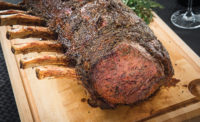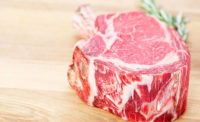This northern California native naturally considered bottom sirloin tri-tip the go-to cut of beef. But as I continue on my lifelong journey to fully understand the greater meat community, I have found another contender. In many circles, if you’re talking versatile and delicious, the conversation turns to a cut that is humble yet elegant: the beef brisket.
A mainstay of the Texas diet and the celebratory protein at nearly all gatherings, Lone Star barbecue terminology for the two main brisket muscles have evolved to rather more gastronomical descriptions over time. You will see the brisket flat, extremely straight grained, versatile and consistent, merchandized at a smokehouse as the “lean” portion. After all, the cooked Flat Half Brisket, average for all grades, has only 6.8 grams of fat per 3-ounce serving. That’s less than my sirloin tri-tip. This portrayal as the lean portion comforts the more timid barbecue amateurs, as does the satisfaction from the dining experience, with its moderate and delightful flavor that covers the plate well but in not such a messy way as to frighten those less familiar with the religion of ’cue.
Then there is the point of the brisket, which has many more alternative names than the more popular flat, yet in the eyes of this meat fanatic, the point is also the more complex and palate stimulating of the two muscles. The point has been called the front end, nose cut, thick cut and the second cut. This juicy cut is also referred to as the “web” muscle because of its lacy web-like appearance of lean and fat when carved.
The brisket point has a tremendous amount of rich, buttery beef flavor that acts as a magnet to those familiar with it, yet its calorie content may keep some folks from frequenting their favorite barbecue joint. But hold your tongs; search the web for news of this muscle and you will find Texas A&M University (TAMU) research that says it contains some of the healthiest fat of any beef cut. But more about that later.
Let’s consider the versatility. Brisket that has been cured, treated with pickling spices and peppercorns is the traditional corned beef first made popular by Irish immigrants as a bacon substitute. That’s why it is a staple around St. Patrick’s Day, when the tasty but salty treat, aligned with tubers and cruciferous vegetables, hits the spot for those in that festive mood.
Change the spice combination slightly and you can make classic brisket pastrami in the Jewish tradition. Some terminology relative to Jewish beef cuts may help in this case. It applies to the two parts of the brisket. The “first cut” refers to the brisket flat — again, the leaner of the two pieces from the brisket — and the “second cut” refers to the brisket point. Either way, slice it thin and pile it high to create quite the symbol of the East Coast delicatessen.
Having those two components, flat and point, the brisket lends itself to further merchandising in other ways as well. The brisket flat, scientifically named the Pectoralis profundus, is easy to separate from the point (Pectoralis superficialis) by the common seam the muscles share. Once separated, the brisket flat is prized in many cases by those seeking an easy-to-carve, lean slicing roast. On the other hand, the brisket point is a great alternative to the boneless beef short rib as its generous marbling produces rich beef flavor.
Either piece from the brisket, cooked properly in “low and slow” style, can become quite tender after the innate collagen content is gelatinized during cooking. Despite a long cooking time, these cuts tend to maintain a typical shape and integrity that lends itself to further applications very well. At our Education & Culinary Center, one of our chefs has created an innovative and fun way to use pre-cooked brisket bits to extend the value even after the main parts have been carved and served. Off-cuts and tips of the brisket can be diced into 1-inch cubes, deep fried, mixed with a complementary dipping sauce and merchandized as “bar candy.” Brilliant!
Now, back to TAMU. Beef brisket has traditionally been served as a whole-muscle cut, but recent findings by Aggie meat scientists suggest the brisket may also be a great item to include as a primary ingredient in ground beef. It seems that’s where the beef animal deposits above-average quantities of oleic acid, a monounsaturated fatty acid — the really good kind of fat, by the way — and it is known to be very desirable to the human palate. Word is getting around about the great taste of brisket, which may be part of the reason there has been a bit of a surge in “premium” ground beef that is made with a high percentage of brisket. Promoters say this brisket-blend ground beef is rich and buttery, which is why we meat lovers tend to gravitate to the brisket in the first place.
The beef brisket, traditionally requiring a more gentle and patient hand during preparation, is a cut of beef that can impress at a great value. NP
Editor’s Note: “Get Real with Beef” is a new column, written by Dr. Phil Bass, corporate meat scientist for the Certified Angus Beef® brand, and Editorial Board Member of The National Provisioner. Watch for his insights, including his take on beef cuts that processors should investigate adding to their product mix (Utilize This!), on a quarterly basis, exclusively in The National Provisioner.







Report Abusive Comment